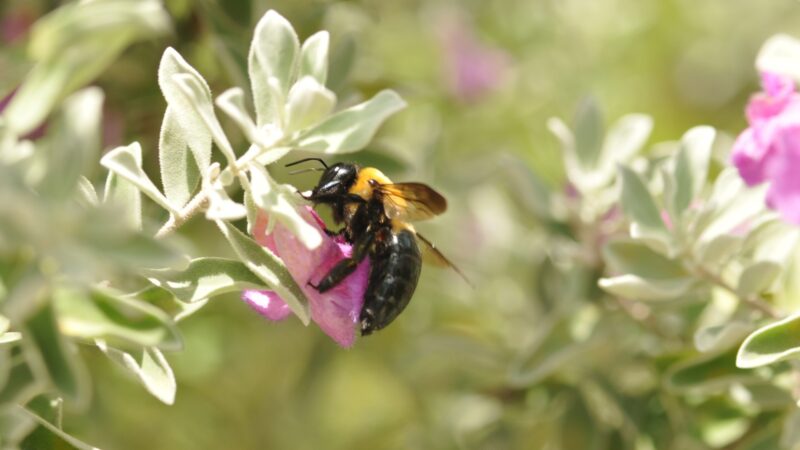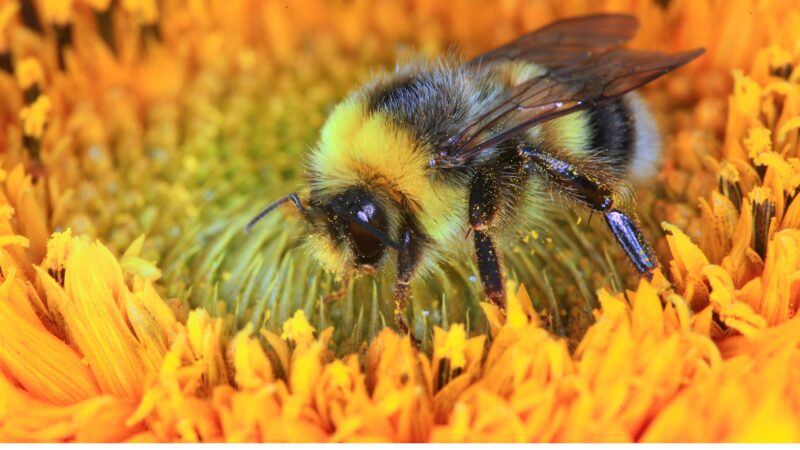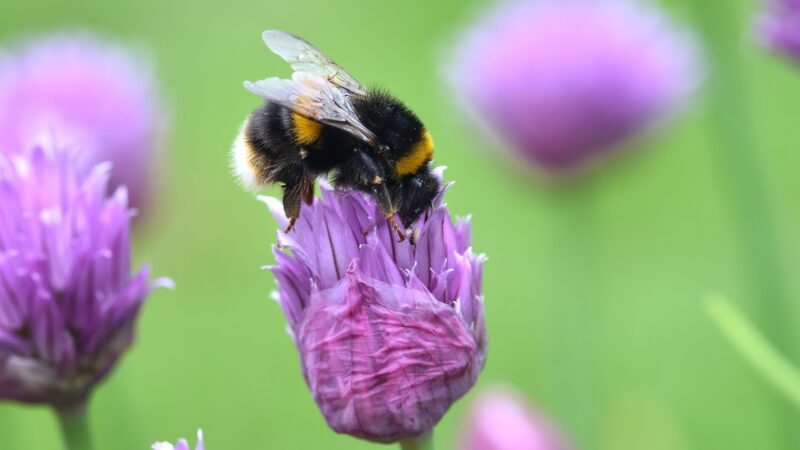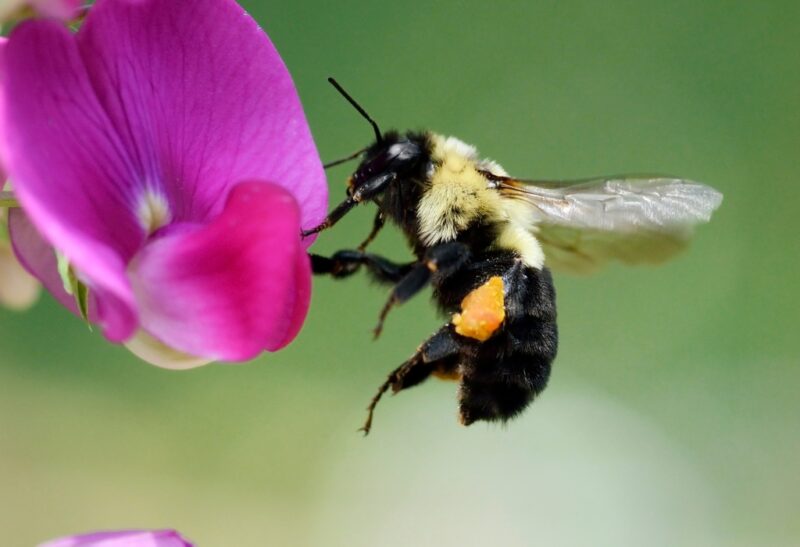Recognizable for their rounded, black-and-yellow, hairy bodies and the way they buzz around flowers, bumble bees are fascinating insects to children, home gardeners, scientists, beekeepers, and breeders. There are currently 49 known species in the United States.
Bumble bees efficiently pollinate wildflowers and crops, such as blueberries, tomatoes, strawberries, and tomatoes, as a means of nutrition and survival. They also produce honey which humans use in food and medicine.
This article discusses everything you need to know about bumble bees, what they do, why they’re so important, what attracts them, and other interesting information. Read further for more!
Table of Contents
Why Are Bumble Bees So Important?

Bumble bees are incredible pollinators of wildflowers and crops. Hence, they can be found anywhere flowering plants are.
Although they are not interchangeable with honey bees for specific plant species, bumble bees are more effective in the labor-intensive pollination of certain greenhouse-grown plants, such as sweet peppers, tomatoes, and strawberries.
What Do Bumble Bees Do?

Bumble bees are pollinators that forage for pollen and nectar during the early spring and early days and can forage even in cool, unfavorable weather conditions more efficiently than other bees. In return, they produce honey which humans use in food and medicine.
Why Are Bumble Bees Great Pollinators?
- Hairy Bodies. All bees have branched hairs all over their bodies that allow them to transfer pollen between flowers. These individual hairs are called setae and are naturally sticky, which makes pollen grains easier to attach. Moreover, these hairs provide the bees with insulation from cold temperatures, enabling them to forage in bad weather.
- Body Temperature. Like other insects, bumble bees cannot control their internal body temperatures. As a result of evolution, however, they shiver to increase their body temperature up to 86°F, helping them forage in the cold.
- Buzz Pollination. Bumble bees perform this specialized behavior by vibrating their flight muscles at the right frequency while being on top of a flower. This movement helps them dislodge pollen held by the anthers of the flower. It is particularly helpful for flowers that have hidden pollen reserves.
- Nutrition. Like other bees, pollination comes naturally since they rely on nectar and pollen for nutrition. This obliges them to visit flowers as a means of survival and to provide for their young successfully.
- Generalist Diet. This means they visit a variety of flower species. They also tend to visit the same species until their nectar and pollen are depleted.
Do Bumble Bees Have Hives?

Bumble bees have hives. They are smaller than honey bee hives since each nest only contains about 50 to 500 individuals.
Bumble bee hives are annual instead of perennial like honey bees and will be abandoned after use. Colonies are usually found in deserted bird or mouse nests, but they are also occasionally found in clothes dryer vents and within wall cavities.
Do Bumble Bees Have a Queen?
Bumble bees have a queen. They are usually twice as large as workers and males in the colony.
The bumble bee queen is responsible for establishing a colony during the spring season after winter diapause, or a phase in a state of developmental arrest, much like hibernation, to survive extreme winter conditions.
What Is the Colony Life of a Bumble Bee?
Spring
- From the spring until the early summer months, bumble bee queens will emerge from their underground alcoves, where they overwinter. They can be seen searching for a suitable location to start a colony, such as rodent holes and other burrows.
- Once the queen finds a good habitat, she forages for pollen and nectar to form wax pots as storage for nectar and feed her first brood of young. It will continuously forage for more resources to allow its brood to grow and develop.
- As the brood develops, they undergo their respective life cycles from egg to larvae to pupa. After 3 to 4 weeks, the first batch of adult female workers will emerge. This is the start of the social phase of the colony.
Summer
- In the early months of summer, the female workers are divided by tasks: there will be nurse workers that feed the colony’s brood and forage workers that track food resources and supply the colony with sufficient nectar and pollen. There will also be workers that defend the nest against predators.
- From here onwards, the queen will remain inside the colony to lay eggs and care for the brood it produces. The entire hive is incubated with temperatures being around 86°F.
Fall
- As the colony reaches its maximum size during the late summer to early fall, the queen will stop producing workers and begin laying unfertilized eggs. These will develop into adult males, called drones, while workers will rear the fertilized eggs into new queens, called gynes.
- Drones and gynes will leave the nest to forage and find a mate. At this point, the original queen of the colony will naturally die together with the remaining workers.
- Gynes will prepare for winter diapause by filling up on nectar and pollen resources.
Winter
- Mated gynes will build up fat reserves and find a suitable place to overwinter, usually by digging into loose soils and thatch.
- Afterward, gynes will enter diapause, which lasts around 6 to 9 months. While in this state, the gyne is completely dominant.
- Once the gynes survive diapause, they will emerge in the spring and start the life cycle of a bumble bee again as the new founder queen.
Are Bumble Bees Aggressive?

Bumble bees are not aggressive. They are not known to be aggressive and are generally not a severe hazard for humans.
However, they will come to defend themselves by stinging when they feel threatened or when their nest is disturbed. Bumble bees have painful stings, and dozens of bees may simultaneously attack if they feel that their nest is threatened.
What Attracts Bumble Bees?
They are attracted to bunch grasses, small fruits, and large patches of flowers that are blue, purple, mauve, white, or yellow.
What Flowers Attract Bumble Bees?
Examples are lavenders, blue blossoms, ocean sprays, serviceberries, zinnias, sunflowers, foxgloves, bleeding hearts, bugleweed, sneezeweed, and coneflowers.
They are also attracted to tithonia, zinnias, borages, geraniums, globe thistles, little leaf lindens, chives, panicle hydrangeas, native honeysuckles, marigolds, blanket flowers, oregano, and catmints.
What Do Bumble Bees Do With Pollen?
Pollen is the main source of protein for bumble bees. It also provides minerals, vitamins, and fats.
Bumble bees use pollen to feed their broods and encourage the development of young bees. This pollen is often stored to provide for new generations of bees in the colony continuously. A colony needs about 15 to 55 kilograms of pollen.
How to Repel Bumble Bees?
Bumble bees are typically docile, so you should not do anything that could disturb their nest. Unless a colony of bumble bees becomes life-threatening to you and the people around you, you can choose to repel them using the following methods:
- Vinegar Spray. Mix a 1:1 ratio of vinegar and water, place in a spray bottle, then spray at the hive during nighttime when the bees have less activity.
- Citrus Spray. In a pan of water, boil lemon slices in it. Stop the boiling once the water has reached one-third of its original volume, then put the resulting lemon water in a spray bottle, then spray against a hive during nighttime.
- Peppermint and Hot Water. Mix 2 to 3 cups of peppermint castile soap in 2 cups. Make sure to keep a container of hot, boiling water at hand. Using a hose or pipe, pour the peppermint mixture, then follow using the boiling water. Make a hasty escape, as the bees may retaliate.
- Ground Cinnamon. Sprinkle cinnamon around the hive during nighttime. You may need to repeat the application to get rid of them completely.
- Citronella Candles. Light these candles in infested areas in your homes if they have started invading them. These can work as effective repellents.
- Bee Zappers. Purchase bee zappers to eliminate bumble bees that fly around your house or its vicinity. However, this means you would have to kill them, and if you’re uncomfortable with that, do not use this method.
How to Relocate Bumble Bees?

Only beekeepers, contractors, and other professionals can relocate bumble bee hives successfully. They do so by locating the nest first using a stethoscope or simply tapping surfaces to listen to the hum of a colony. Once located, the bees are removed from their combs, usually using a vacuum device.
This process usually stimulates bees to release alarm pheromones that increase their defensive behavior, hence why these professionals must wear a bee suit and other protective equipment.
Once the bees are safely inside the vacuum, the nest is either removed and discarded or relocated to a safer, further location where they can’t disturb humans.
What Eats Bumble Bees?
Raccoons, bears, hive beetles, badgers, crab spiders, shrikes, flycatchers, and skunks are among the bumble bees’ most common predators.
Where Bumble Bees Live?
Bumble bees are considered cavity-nesting bees, which means you can find their nests in wall or rock cavities, tussocky grass, and bird or rodent burrows. They can also build their hives near woodland edges where there is a lot of fallen timber.
How Long Do Bumble Bees Live?
It depends on the species and the role they play in the colony. Worker bees live an average of 4 weeks, drones can live up to 55 days, and queens can live up to 12 months or until they have fully established a colony.
Why Are Bumble Bees So Fat?
Bumble bees are so fat because they store a lot of nectar and pollen in their bodies.
How Can You Tell if a Bumble Bee Is Male or Female?
Females have a flashy, flat-looking segment located on their back legs, referred to as a pollen basket that holds pollen. Males do not collect pollen and are usually hairier, with longer antennae.
How Many Eyes Does a Bumble Bee Have?
They have 5 eyes: 2 large eyes at the sides of the head and 3 eyes on the top of it.
List of Sources
The Bumble Bee Lifestyle – https://extension.psu.edu/the-bumble-bee-lifestyle
